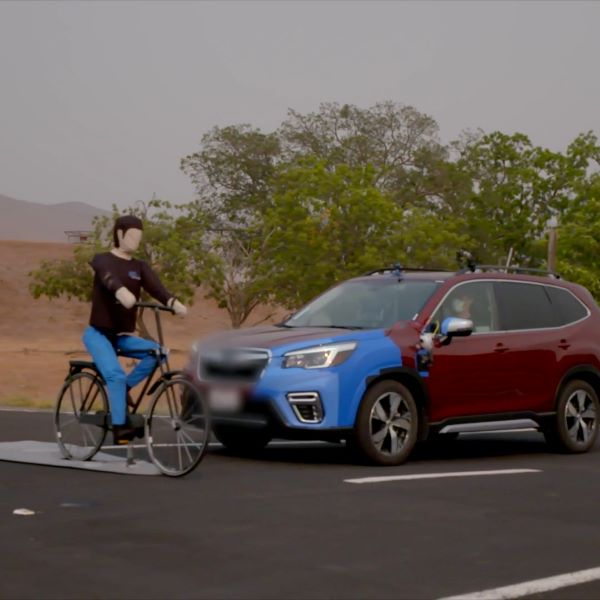Consumer Skepticism Toward Autonomous Driving Features Justified
Consumer Skepticism Toward Autonomous Driving Features Justified

In AAA's latest survey of attitudes about automated vehicles, drivers overwhelmingly want automakers to improve the performance of existing driver support features rather than develop self-driving cars. And this desire is backed by another round of AAA testing that reveals inconsistent performance remains a problem with available driving assistance systems, resulting in crashes with a car and a bicyclist. The failures occurred regardless of vehicle make and model. It is the third time AAA has studied these systems' performance. AAA urges automakers to listen to consumers and improve what is currently available before focusing on future technology.
"You can't sell consumers on the future if they don't trust the present," said Greg Brannon, director of AAA's automotive engineering. "And drivers tell us they expect their current driving assistance technology to perform safely all the time. But unfortunately, our testing demonstrates spotty performance is the norm rather than the exception."
Consumers surveyed told AAA they are more interested in improved vehicle safety systems (77%) versus self-driving cars (18%). But new testing, the third round by AAA's Automotive Engineering team in the last few years, found that vehicles with an active driving assistance system (also known as Level 2 systems as defined by SAE) failed to consistently avoid crashes with another car or bicycle during 15 test runs. A foam car similar to a small hatchback and a bicyclist dummy was used for this testing.
- A head-on collision occurred during all 15 test runs for an oncoming vehicle within the travel lane. Only one test vehicle significantly reduced speed before a crash on each run.
- For a slow lead vehicle moving in the same direction in the lane ahead, no collisions occurred among 15 test runs.
- For a cyclist crossing the travel lane of the test vehicle, a collision occurred for 5 out of 15 test runs, or 33% of the time.
- For a cyclist traveling in the same direction in the lane ahead of the test vehicle, no collisions occurred among 15 test runs.
While the refinement of available active driving assistance systems improves, drivers must remain continuously engaged in the driving task. The research vehicles performed as expected during the closed-course testing for routine situations, such as approaching a slowing moving vehicle or bicyclist from behind. However, all test vehicles collided with either the simulated passenger car or the adult cyclist multiple times during "edge-case" testing, like a car approaching head-on or a bicyclist crossing directly in front of the test car. This reinforces recent AAA research calling for direct driver monitoring systems with camera-based technology to be integrated into active driving assistance systems.
"While it may be encouraging that these driving systems successfully spotted slow-moving cars and bicyclists in the same lane, the failure to spot a crossing bike rider or an oncoming vehicle is alarming," said Brannon. "A head-on crash is the deadliest kind, and these systems should be optimized for the situations where they can help the most."
Active driving assistance systems are widely available and often called semi-autonomous because they combine vehicle acceleration with braking and steering. Since 2016, AAA has surveyed consumers about driving assistance systems and self-driving cars to track sentiment regarding emerging vehicle technology.
Key survey findings demonstrate that while consumer interest in driving assistance vehicle technology remains steady, there is more interest in familiar features that consumers perceive to be designed for their safety, such as automatic emergency braking.
Meanwhile, consumer distrust of fully self-driving vehicles remains high. AAA found 85% are fearful or unsure of self-driving technology, a level that has remained steady for the past several years. When transporting their children or loved ones, 85% also said they would not be comfortable with using a self-driving vehicle.
A troubling belief in commercially available self-driving cars was also revealed in the data, with 12% incorrectly thinking they could buy such a vehicle while 53% were unsure if they could.
Previously, AAA found that active driving assistance systems failed to maintain lane position in real-world conditions consistently and had other challenges in closed-course testing. To see the details of these previous research projects, please visit the AAA Newsroom.
Consumer Survey Methodology
The AAA consumer survey was conducted on January 13-16, 2022, using a probability-based panel to represent the U.S. household population overall. The panel provides sample coverage of approximately 97% of the U.S. household population. Most surveys were completed online; consumers without Internet access were surveyed over the phone. A total of 1,107 interviews were conducted among U.S. adults 18 years of age or older. The margin of error for the study is 4% at the 95% confidence level.
Vehicle Testing Methodology
Closed course testing occurred at AAA Northern California, Nevada, and Utah's GoMentum Station proving ground in Concord, California. Using a defined set of criteria, AAA selected the following vehicles for testing: 2021 Subaru Forester with "EyeSight®," 2021 Hyundai Santa Fe with "Highway Driving Assist," 2020 Tesla Model 3 with "Autopilot" and were sourced from the manufacturer or specialty rental fleets. Please refer to the full report for specific methodology regarding testing equipment and closed-course test scenarios.
About AAA
Started in 1902 by automotive enthusiasts who wanted to chart a path for better roads in America and advocate for safe mobility, AAA has transformed into one of North America's largest membership organizations. Today, AAA provides roadside assistance, travel, discounts, financial and insurance services to enhance the life journey of 62 million members across North America, including 56 million in the United States. To learn more about all AAA offers or become a member, visit AAA.com.












